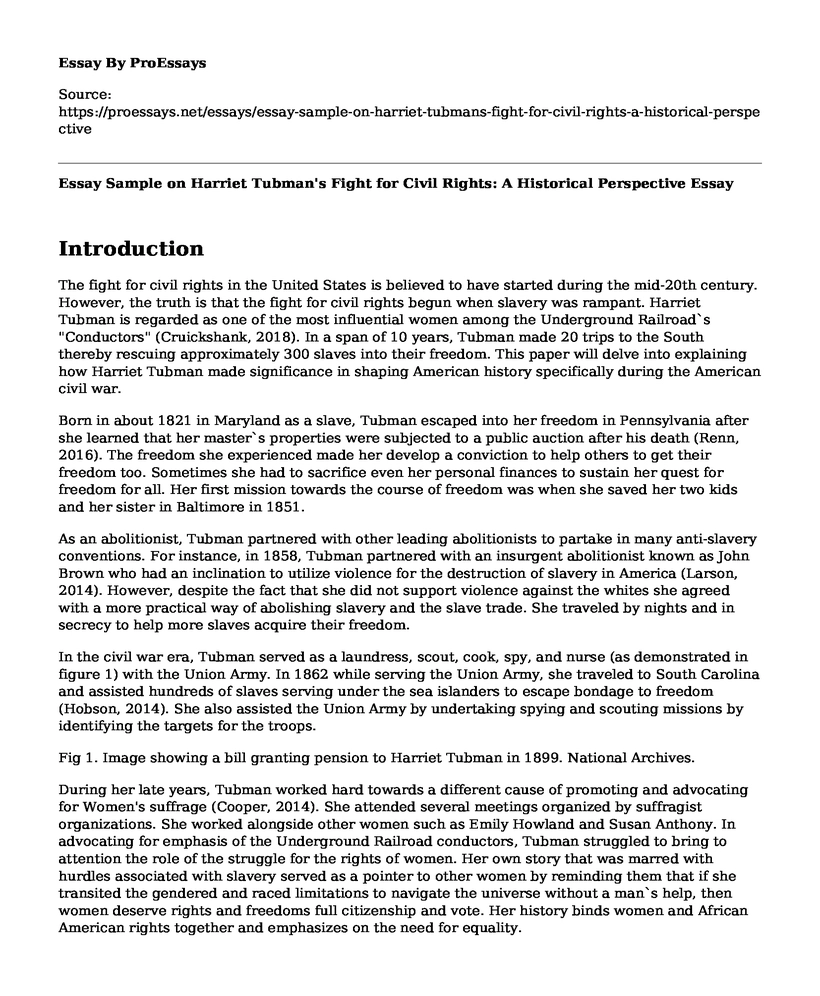Introduction
The fight for civil rights in the United States is believed to have started during the mid-20th century. However, the truth is that the fight for civil rights begun when slavery was rampant. Harriet Tubman is regarded as one of the most influential women among the Underground Railroad`s "Conductors" (Cruickshank, 2018). In a span of 10 years, Tubman made 20 trips to the South thereby rescuing approximately 300 slaves into their freedom. This paper will delve into explaining how Harriet Tubman made significance in shaping American history specifically during the American civil war.
Born in about 1821 in Maryland as a slave, Tubman escaped into her freedom in Pennsylvania after she learned that her master`s properties were subjected to a public auction after his death (Renn, 2016). The freedom she experienced made her develop a conviction to help others to get their freedom too. Sometimes she had to sacrifice even her personal finances to sustain her quest for freedom for all. Her first mission towards the course of freedom was when she saved her two kids and her sister in Baltimore in 1851.
As an abolitionist, Tubman partnered with other leading abolitionists to partake in many anti-slavery conventions. For instance, in 1858, Tubman partnered with an insurgent abolitionist known as John Brown who had an inclination to utilize violence for the destruction of slavery in America (Larson, 2014). However, despite the fact that she did not support violence against the whites she agreed with a more practical way of abolishing slavery and the slave trade. She traveled by nights and in secrecy to help more slaves acquire their freedom.
In the civil war era, Tubman served as a laundress, scout, cook, spy, and nurse (as demonstrated in figure 1) with the Union Army. In 1862 while serving the Union Army, she traveled to South Carolina and assisted hundreds of slaves serving under the sea islanders to escape bondage to freedom (Hobson, 2014). She also assisted the Union Army by undertaking spying and scouting missions by identifying the targets for the troops.
Fig 1. Image showing a bill granting pension to Harriet Tubman in 1899. National Archives.
During her late years, Tubman worked hard towards a different cause of promoting and advocating for Women's suffrage (Cooper, 2014). She attended several meetings organized by suffragist organizations. She worked alongside other women such as Emily Howland and Susan Anthony. In advocating for emphasis of the Underground Railroad conductors, Tubman struggled to bring to attention the role of the struggle for the rights of women. Her own story that was marred with hurdles associated with slavery served as a pointer to other women by reminding them that if she transited the gendered and raced limitations to navigate the universe without a man`s help, then women deserve rights and freedoms full citizenship and vote. Her history binds women and African American rights together and emphasizes on the need for equality.
Conclusion
In conclusion, before her death in 1913, Tubman, although a woman, was a very significant force during the fight for civil rights. Her devotion towards the rescue of the slaves captured in various scenarios is appealing to historians and places her among one of the greatest nationals by American history. Furthermore, she also helped in the rights of African American and women specifically in the rights to full citizenship and the right to vote. As a result, after her death, she has received numerous honors. For instance, the Liberty ship was named after her by Eleanor Roosevelt in 1944. Today, she is popular because she utilized her potential as an African American to turn things into being different and better for the benefit of society.
References
Cooper. (2014). Does Anyone Care about Black Women? Meridians, 12(2), 153. doi:10.2979/meridians.12.2.153
Cruickshank, S. (2018). Harriet Tubman, real-life action hero. Retrieved from https://hub.jhu.edu/2018/03/08/harriet-tubman-hero-wyman-park-dell/
Hobson. (2014). Harriet Tubman: A Legacy of Resistance. Meridians, 12(2), 1. doi:10.2979/meridians.12.2.1
Larson, K. (2014). Harriet Ross Tubman: Timeline. Meridians,12(2), 9-27. doi:10.2979/meridians.12.2.9
Renn, S. (2016). The life and accomplishments of Harriet Tubman. Retrieved from http://www.moabsunnews.com/news/article_4b6d7650-d659-11e5-bb32-f3808b5ef397.html
Cite this page
Essay Sample on Harriet Tubman's Fight for Civil Rights: A Historical Perspective. (2023, Jan 12). Retrieved from https://proessays.net/essays/essay-sample-on-harriet-tubmans-fight-for-civil-rights-a-historical-perspective
If you are the original author of this essay and no longer wish to have it published on the ProEssays website, please click below to request its removal:
- Essay Sample on High Tech Crimes
- Essay Sample on Uncovering Freedom: America's Founding Cultural Artifact
- Colonial Slave Labor: Issues and Implications - Essay Sample
- U.S. Prisons: Angola Louisiana State Correctional Facility - Essay Sample
- Organized Crime: Criminal Organizations, Terrorist Groups, and Militias - Essay Sample
- Essay Example on Antitrust Law: Efficiency or Justice?
- Paper Example on Washington Supreme Court: Rule of Law & Court Structure







